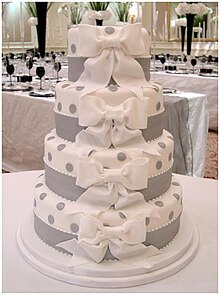Wedding cake: Difference between revisions
m Reverted edits by 200.42.55.76 (talk) to last version by Gilesbennett |
|||
| Line 50: | Line 50: | ||
==External links== |
==External links== |
||
*[http://www.cakeswedding.co.uk/world-cake-traditions.shtml Global Wedding Cake Traditions] |
*[http://www.cakeswedding.co.uk/world-cake-traditions.shtml Global Wedding Cake Traditions] |
||
*[http://strictlyweddings.com/category.php?currentSection=4 Wedding Cake Dallas] |
|||
Revision as of 14:08, 31 January 2008


A wedding cake is the traditional cake served to the guests at a wedding reception (or in parts of England, at a wedding breakfast) after a wedding. In modern western culture, it is usually a large cake, multi-layered or tiered, and heavily decorated with icing, occasionally over a layer of marzipan or fondant, topped with a small statue representing the couple. Other common motifs include doves, gold rings and horseshoes, the latter symbolising good luck. Achieving a dense, strong cake that can support the decorations while remaining edible can be considered the epitome of the baker's art and skill. The average cost of a wedding cake in the U.S. in 2005 was $543.[1]
Tradition generally requires that the first cut of the cake be performed by bride and groom together, often with a ceremonial knife or even a sword. An older, archaic tradition had the bride serve all portions to the groom's family as a symbolic transfer of her household labor from her family to the groom's family.
Tradition may also dictate that the bride and groom feed the first bites of this cake to each other. Again, this may symbolize the new family unit formed and the replacement of the old parent-child union.
Other guests may then partake of the cake, portions may be taken home or shipped to people who missed the festivities. (An old tradition held that if a bridesmaid slept with a piece of wedding cake beneath her pillow she might dream of her future husband.)
A portion may be stored, and eaten by the couple at their first wedding anniversary, or at the christening of their first child. Sometimes this portion is the top tier, and sometimes a portion of the piece from which the bride and groom fed each other, depending on the local customs. The portion of the cake may be frozen for this purpose; the top tier of the cake may sometimes consist of fruitcake, which could be stored for a great length of time.
History

The origins of the tradition of the wedding cake date back to medieval times, when each guest at a wedding was supposed to bring a small cake, the cakes would be stacked on the table in levels and layers (If the bride and groom were able to kiss over the top of the stack it was considered good luck). These cake stacks would eventually merge into one cake and evolve into the modern wedding cake. Sweets are traditional at many celebrations for most if not all cultures worldwide. Ancient Roman records detail sweets distributed at weddings. The book Folklore Myths and Legends of Britain details the ancient Roman practice of dropping a wedding cake on the head of the bride. Medieval and Renaissance resources also mention large cakes at weddings. Such cakes may have been fruitcake.
A large cake can take a long time to make, and without modern refrigeration, a heavy fat and sugar frosting may have prevented spoilage by limiting moisture exposure. Another possibility is the use of sugar and fat required satisfying the need for conspicuous consumption for the families involved in the wedding.
The tiered design of the wedding cake originates from the tiered spire of a well known medieval church in London, England, called St Bride's Church.
Henry VIII of England enacted a law specifying the quantity of sugar a cake may have, possibly to control or tax this prevailing convention.
During World War II, sugar was rationed in Great Britain, so icing could not be made, and cakes were reduced in size. To overcome this cakes were often served inside a box, which had been decorated with plaster of Paris, to resemble a larger, traditional cake.
Modern adaptions

Recently some western weddings have started to use cupcakes or other individually sized dessert items in place of a larger tiered cake. These individual cakes are often arranged in tiers to represent the shape of the traditional tiered cake.
Wedding cake toppers are small models that sit on top of the cake, normally a representation of a bride and groom in formal wedding attire. This custom was dominant in US wedding in the 1950s where it represented togetherness.[2] Modern weddings have embraced more variety in design and significance. Wedding toppers today are often figures that indicate shared hobbies or other passions.[2]

See also
- White wedding
- Cake Pull
- Stack cake
- Wedding dress
- Croquembouche - A French wedding cake tradition
- Kransekage - A Scandinavian wedding cake tradition
References
- ^ The Wedding Report, market research from the Bridal Association of America, 2005. Retrieved August 16 2007.
- ^ a b Cele Otones and Elizabeth Pleck (2003), Cinderella Dreams: The Allure of the Lavish Wedding, University of California Press, p. 124-125, ISBN 0-520-24008-1
